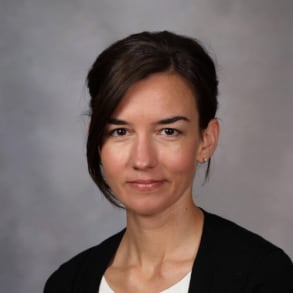Lilly H. Wagner, M.D., is an ophthalmologist and oculoplastic surgeon at Mayo Clinic in Rochester, Minnesota. Dr. Wagner performs the second stage of an upper eyelid reconstruction on a patient who had sebaceous carcinoma. Watch Dr. Wagner separate the Cutler-Beard flap in this procedure.
So this patient is five weeks out now from an upper lip reconstruction with the Cutler beard flap and we're going to separate the flap. Today she had a sebaceous cell carcinoma and there was some residual tumor found at the temporal margin on permanent pathology. So we're also going to excise and additional wedge of tissue temporarily and right now just marking out the tissues that we're going to exercise and we're just making a full thickness incision. Through this flap our flap is separated. We can release the lower lid bridge, we have to just freshen up the skin so we can close the defect. Now we're going to excise the additional wedge and we're going to remove basically just our old scar. But here's our main specimen that will just be processed. We're sending a margin here. Here's our additional wedge excision with the nasal and temporal margin. So we're gonna send off now to close our upper lip full thickness defect. And before we close it we're just going to respect a little bit of skin or just approximating the new lid margin to this remaining normal lead margin here on the temporal side, about the level of the lash line. This is just like we would do a full thickness repair except in this operated flap instead of tarsus, we have an a cellular dermis, al Durham graph that I placed when I did the cattle beard flap. So here's our temporarily tight silk suture will just confirm that it's good position before we close, will secure a condom table edge before repair that. So now that we have our margin repaired and we have a nice mucosal edge on the margin. And we have our full thickness defect repair deep. Just place one silk suture in the skin, just superior to the margin to be able to tie our tails away from the eye. But we can close this lower defect first. Now a little bit irregular edge here. So we're just going to put some interrupted sutures into the lower island. We can excise a small dog here and for this dog here you just extend your incision and this concludes our second stage Cutler beard and additional wedge excision for a sebaceous carcinoma of the upper eyelid. This is a patient that was referred to us for chronic irritation and lash loss and was found to have sebaceous cell carcinoma. In the upper eyelid we proceeded to excise this with frozen sections. After we confirmed with content table map biopsies that The upper eyelid was the only area that was involved. And this picture shows the eyelid. After the initial resection you can see that about 90% of the upper eyelid is missing. Could reconstruct with a Cutler beard flap. And then here you see the patient, one week out after the reconstruction you can see there's a bridge of tissue from the lower eyelid brought up into the upper lid. The lid margin and tarsus of the lower eyelid remain in place. And today we did the second stage which is usually done 6-8 weeks after the first stage and involves separation of the flap and repair of the incision under the lower lid. Mm hmm mm. Hmm mm hmm. Mhm.

